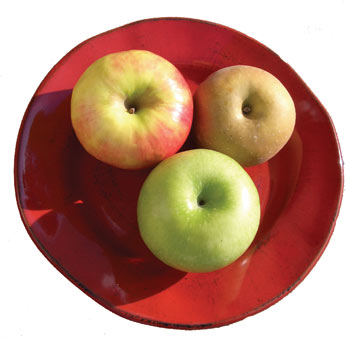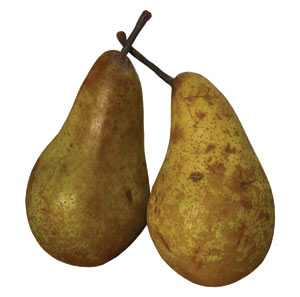|
|
Fructose intolerance, including FODMAPs |
|||||||||||||||||||||||||||||||||||||||||||||||||||||||||||||||||||||||||||||||||||||||||||||||||||||||||||||||||
|
Dr Janice Joneja tells us what we need to know. Fructose intolerance, especially among children, probably occurs more frequently than diagnostic figures suggest.[1] Typical symptoms include loose stools or diarrhea after consumption of fruits such as apples and pears or the juice of these fruits. Fructose intolerance is usually caused by impaired absorption of fructose. However, there are rare cases in which intolerance of fructose is due to a deficiency in one of the enzymes responsible for the digestion of fructose (see “Inherited Conditions Causing Fructose Intolerance” below). Fructose is consumed in three forms: • As the pure monosaccharide, fructose;
FODMAP and the Inability to Digest Fructose Polymers An inability to digest and absorb fructose polymers (chains of fructose molecules) is not an intolerance in the food sensitivity sense because all humans lack the enzymes needed to split the bonds between the fructose molecules in the chain. Molecules of fructose are therefore not free to be transported through the gut wall and instead remain within the gut. The term fermentable oligosaccharides, disaccharides, monosaccharides, and polyols (FODMAP) [2] has been introduced to define a previously apparently unrelated group of poorly absorbed short-chain carbohydrates and sugar alcohols that move into the small bowel and colon, where they are fermented by the resident microflora, producing symptoms of excessive gas, abdominal bloating, pain, and diarrhea. Strictly speaking, these symptoms do not indicate intolerance, because anyone consuming large quantities of FODMAPs will develop them; this is not an idiosyncratic response limited only to sensitive people. However, intake of FODMAPs has been identified as a possible cause of gastro-intestinal symptoms, especially in individuals who have been diagnosed with irritable bowel syndrome. As a result, the FODMAP diet, [3] which eliminates excess fructose, fructose polymers, and sugar alcohols, is often followed in an attempt to reduce gastrointestinal symptoms. The following section provides information explicitly for the management of diagnosed fructose intolerance. The Mechanism of Fructose Malabsorption Intestinal fructose absorption depends on the low-affinity transporter molecule GLUT2, which will carry the monosaccharides glucose, fructose, and galactose across the small intestine epithelium (through the gut wall). GLUT2 transports the sugars down a concentration gradient which is facilitated by glucose, which permits lower concentrations of glucose to be taken up by the cell by an active process. [4] The process is not entirely understood, but because glucose is more easily absorbed, excess fructose may not get absorbed. This unabsorbed fructose will move into the large bowel, where it causes an increase in osmotic pressure and a net influx or reduced outflow of water, resulting in loose stool or diarrhea. It also acts as a substrate for microbial fermentation with production of gas (especially hydrogen) and organic acids. These activities are responsible for the symptoms of fructose intolerance. Sucrose contains both glucose and fructose in a 1:1 ratio. Consumption of sucrose does not result in malabsorption of fructose, because when sucrose is split into its constituent monosaccharide sugars by sucrase, the fructose level does not exceed that of the glucose. However, some sucrose-containing fruits contain a higher fructose-to-glucose ratio than most other fruits.
Diarrhea after eating apples, pears, watermelon, blackcurrant, cherries—or juices from these fruits—and honey and high fructose corn syrup, when no other cause for the loose stool is evident, is a sign that fructose malabsorption may be the problem. [5,6] Absorption of Fructose Only a limited amount of ‘free’ fructose can be absorbed in the small intestine, with up to one-half of the population unable to completely absorb a dose of 25g of fructose. [7] Average daily intake of fructose is estimated to vary from 11g to 54g around the world, depending on the dietary habits of the population sampled. When used as a sweetener in soft drinks as consumed in Western countries, fructose can quickly approach levels at which malabsorption is seen in healthy adults. Evidence suggests that when solutions containing 25g to 50g of fructose (equivalent to more than 500 mL of sweetened soft drink) are consumed, more than 50% of healthy subjects demonstrate malabsorption of fructose and consequently experience symptoms of abdominal pain, gas, and loose bowels. [8] The high fructose content in sports drinks has also been implicated in adverse athletic performance and abdominal symptoms. [9] Diagnosis Diagnosis of fructose intolerance can be confirmed by a hydrogen breath test. The patient consumes a drink made of water containing a known amount of fructose powder dissolved in it. For the next 2 hours, the amount of hydrogen in the person’s breath is measured every 15 minutes by having him or her breathe into a tube attached to a measuring device. If the fructose is not carried across the digestive tract lining and transported into circulation (which is what happens in people without fructose malabsorption), it moves into the large bowel, where it is fermented by the resident microorganisms. A major product of fermentation is hydrogen. The hydrogen produced by fructose fermentation passes from the bowel into circulation, is removed in the lungs, and finally excreted in the breath. This method of testing is often used to diagnose lactose intolerance, but malabsorption of any sugar can be tested in the same way. However, the problem with this method of testing for fructose intolerance is that if an excessive quantity of fructose is consumed, everyone will experience some degree of malabsorption and will develop loose stool and an increase in breath hydrogen. Usually the quantity of fructose used in the test is 2mg/kg body weight (that means a child of 15kg would be tested with a dose of 30mg of fructose in water). This is the amount of fructose that is usually tolerated by most people who do not have clinical fructose malabsorption.
Inherited Conditions Causing Fructose Intolerance Although many people, especially children, develop loose stool and diarrhea after consuming a high dose of fructose, there are inherited conditions in which metabolism of fructose is impaired and that require more careful avoidance of all sources of fructose. This may include avoidance of sucrose, sorbitol, and the polymerized forms of fructose listed above, depending on the mechanism of the deficiency. These diseases are more accurately described as inborn errors of metabolism, and are relatively rare. [10] Diagnosis and treatment typically takes place in a specialised clinic staffed by specially trained doctors, registered dietitians, nurses, and other health care practitioners. The most well-known conditions include fructose-1,6-bisphosphatase deficiency, hereditary fructose intolerance, and essential fructosuria.
Management of Fructose Intolerance Management of fructose intolerance involves reducing the intake of foods that contain fructose. [15] A fructose-restricted diet inevitably means limiting the consumption of fruit, especially those with a high fructose-to-glucose ratio. It is usually only necessary to avoid the fruits and foods that contain considerably more fructose than glucose. The worst culprits These foods have a high fructose-to-glucose ratio and should be avoided by people on a fructose-restricted diet. Foods with an equal fructose-to-glucose ratio (ie, those with a ratio that is close to 1:1) or low fructose (higher glucose than fructose level) need not be avoided. Grapes and the raisins derived from them are sometimes listed as a ‘high fructose fruit’, but levels of fructose vary between varieties of grapes and methods of measuring fructose. Furthermore, where there is a difference between glucose and fructose content, it is relatively small. Fruits with approximately the same levels of glucose and fructose may be tolerated when they are eaten in small to moderate quantities. However, if a large amount of fruit is consumed, the amount of fructose released from sucrose may exceed the overall ability of the system to transport it efficiently across the digestive lining. Unabsorbed fructose then moves into the large bowel and causes the symptoms previously described. In addition, the sugar content of a fruit will change with the degree of ripeness; the riper the fruit, the more likely a person will react to it. Some practitioners suggest a limit of fructose consumption to reduce the possibility of symptom development in gastrointestinal disorders such as IBS (see FODMAPs diet earlier). A 2010 review suggests the following should be avoided: Fruit juices are more of a problem than the whole fruit, because the sugar tends to be concentrated in the juice, which will then have a higher level of fructose than the whole fruit. It is always wise to dilute all fruit juices in a 1:1 ratio for children younger than 7 years. Since fruit is an important source of vitamin C, supplementary vitamin C may be necessary for individuals following a low-fructose diet. This is especially important for children, who have the most frequent problem with fructose intolerance. Consult the Dietary Reference Intakes to identify daily requirements for healthy individuals.
Additional Sources of Fructose Fructose is sweeter than sucrose and much sweeter than glucose. Hence, fructose is sometimes added to reduced-calorie foods to increase the sweet taste, without the extra calories of sucrose that would be required to give the same amount of sweetness. Fructose is often used in foods recommended for diabetics to provide sweetness, while avoiding the insulin-dependent mechanisms required for metabolism of glucose. These additional sources of fructose need to be avoided by people who have a problem with the absorption of fructose. Fructose on Product Labels There are no government regulations requiring fructose to be identified on a product label in the way an allergen is listed. If fructose is included in a product, it may appear on a food label as: The Practical Approach Fructose malabsorption is an individual characteristic. The level of fruit or juice that each person can tolerate will probably require some experimentation with different fruits and different quantities of each. A practical approach to determining the foods involved in individual cases is to start by limiting the foods with a high fructose-to-glucose ratio (see list below). If symptoms remain the intake of other fruits should be limited until the symptoms resolve. A person’s limit of tolerance (the amount he or she can consume without symptoms) can then be determined by reintroducing fruits in small quantities while avoiding those with a high fructose content. Foods likely to be problematic in fructose intolerance • Apple
References 1. Gaby AR. Adverse effects of dietary fructose. Altern Med Rev. 2005;10:294-306. Additional Resources Look for Food Allergies and Intolerances: Client Education Tools for Dietary Management at the Academy of Nutrition and Dietetics online store. First published September 2014 |


 are:
are:










